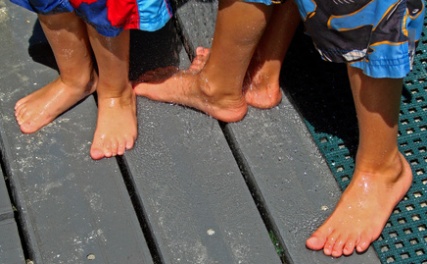
Is the athlete’s foot contagious? It sure is! It is very easy to catch an athlete’s foot. We’ll tell you how it is spread, how to prevent catching it (or spreading it to others), and how to treat it if you do happen to catch it. We’ll let you know about our top recommended athlete’s foot medicine, too.
What Is Athlete’s Foot?
First, let’s talk a little about what an athlete’s foot is. It’s a fungal infection of the skin on your feet. Athlete’s foot is caused by a type of fungus known as ringworm. You can get ringworm anywhere on your body, but when it appears on the foot it is often referred to as athlete’s foot. That’s because athletes often pick it up walking around barefoot on warm, wet locker room floors. The medical term for the condition, however, is tinea pedis.
Athlete’s foot causes an itchy red rash on the feet. You can get it on both feet at once or just on one foot. It is often especially bad between the toes. The rash may be circular in appearance.
The skin may become scaly and it might even crack and bleed. Skin ulcers, or sores, may develop on the feet. If that happens, your feet can hurt a lot. You can also get a secondary bacterial infection if you develop sores on your feet. If you develop signs of infection, like increasing redness, swelling, oozing from the sores, fever, or severe pain, see your doctor. You may need antibiotics.
How Is Athlete’s Foot Contagious?
To get athlete’s foot, all you have to do comes in contact with the fungus with your bare feet. If someone with athlete’s foot walks barefoot on a locker room floor and you walk barefoot on the same floor, you can catch it. The fungus lives easily in warm, wet places, so you are especially likely to pick it up in places like locker rooms, public showers, and pool decks, although you can get it other places, too.
In addition to contracting athlete’s foot by walking on contaminated surfaces, you can get it by sharing personal items like shoes or towels with someone who has it. You can also get it through direct skin-to-skin contact with someone that has it. It is also possible to get ringworm from pets that have it or from contaminated soil, although that is not very common.

How Can You Prevent Athlete’s Foot?
When you understand how an athlete’s foot is transmitted, you can take steps to prevent catching the condition or spreading it to others if you do catch it yourself.
Wear flip flops or shower shoes in locker rooms, showers, and on pool decks. In addition, locker room floors and public showers should be cleaned and disinfected frequently. It is possible to contract an athlete’s foot from a floor that looks clean, though, so you should still wear shoes. Going barefoot at home is fine, as it allows your feet to air out. Be cautious about going barefoot in public places, though.
Don’t share personal items like shoes or towels, since athlete’s foot can be spread that way.
In addition, the Mayo Clinic recommends keeping your feet dry, changing your socks if they get wet or sweaty, and not wearing the same pair of shoes every day so your shoes can have time to dry out. That’s because the fungus that causes athlete’s foot thrives in warm, moist environments.
Finally, if you do get an athlete’s foot, treat it as soon as possible so you won’t spread it to other people. Of course, you’ll also want to get treatment to relieve the itching and discomfort caused by the condition. Prompt treatment may also prevent the development of ulcers on your feet.
Top Recommended Athlete’s Foot Medicine
Athlete’s foot can usually be treated with over-the-counter medication. Or course, you should see your doctor if over-the-counter medicine does not work, if you think you are developing a secondary bacterial infection, or if you have severe pain in your feet. After researching the available options, the medication we recommend is a 100 percent natural formula called H-Athlete’s Foot Formula. It contains homeopathic ingredients and essential oils that relieve the itching and discomfort of athlete’s foot while killing the fungus that causes the condition. To learn more about our top recommended treatment for athlete’s foot, just follow the link. Make sure to keep your feet dry and take steps to prevent re-infection during the treatment process.
